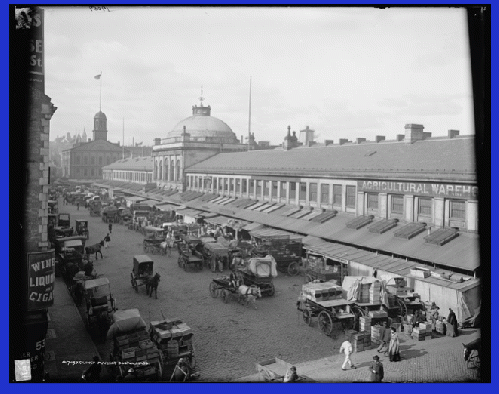I thought it might be fun if I could locate the spot from which it was taken, and see if I could take the same picture today for comparison. So I went searching along the lakefront and sure enough I found the spot at Fullerton Avenue beach, looking south. I took the picture and compared them side-by-side. Now, of course, there is the Chicago skyline and Navy Pier which weren't there in 1905.
For whatever reason, I thought I'd try to combine them into a single image and see what it might look like. And it looked like this:
So, this is the one that started it all. Now, three years later, I have created over 250 Time After Time images across 10 US cities; published six books; and have even been commissioned to create four Time After Time images for George Washington's Mount Vernon in Virginia, where my work is now featured -- at the home of the first President of the United States!
JB: Wow! That's impressive. At what point did you decide to move beyond Chicago and how did you go about that? Which cities are in your stable, why, and do you plan to expand further?
MH: I think I began to consider doing other cities almost immediately. I grew up on the East Coast so cities such as Boston, New York and Washington DC were the first three cities I did. I also wanted to do cities with which I had deep ties. First among them was San Francisco, one of my favorite cities in the world. What made it all the more interesting to me was the source images I was able to obtain. All of the original photographs in my San Francisco Time After Time set were taken in 1906, in the aftermath of the San Francisco earthquake and fire. I wanted to show how San Francisco was reborn in the century that followed so I spent several days shooting my pictures from the same locations as the post-earthquake pictures. The resulting images show what arose from the rubble of some of San Francisco's most well-known streets and neighborhoods.
If I may share a little story with you, one of my personal favorites in my entire collection is of the Phelan Building on San Francisco's Market Street, the burnt-out pie-shaped building seen here in 1906. The original photograph is so dramatic, with the citizens of San Francisco walking amidst the ruins of their city:

helan Building on San Francisco's Market Street, 1906
(Image by courtesy of Mark Hersch) Details DMCA
And here is my Time After Time re-creation of that image:
What makes this image so compelling to me is that the original Phelan Building actually survived the earthquake and fire, but was so heavily damaged it had to be demolished. It was rebuilt in the same triangular shape, much more heavily fortified, and re-opened in 1908, becoming the first major commercial building to re-open in San Francisco. So while there are other better-known buildings in the city (such as the TransAmerica Pyramid), to me, the Phelan Building is the most important building in the city, as it was the one that said to the world, "we are coming back."
Other cities in the collection are Detroit, Pittsburgh, Philadelphia, Savannah and New Orleans. I have several additional Time After Time cities in the works, including some outside of the US.
JB: Can you walk us through a photograph from one of your favorite East Coast cities? This is fun and I'm not ready to let you go yet. I'm enjoying your stories and assuming you have more to share.
MH: Another one of my favorites is a scene from my original hometown, "Quincy Market" in Boston:
Again, the original photo shot in 1904 has all the elements I look for in a source image, with great period reference points. Quincy Market then was the center of commerce in Boston, with food vendors selling everything from meats, cheeses and produce to alcohol and tobacco.
(Note: You can view every article as one long page if you sign up as an Advocate Member, or higher).








